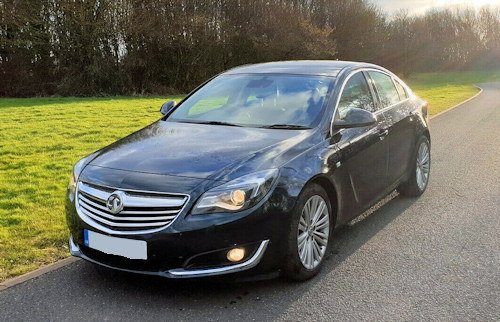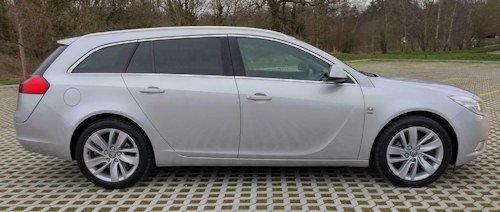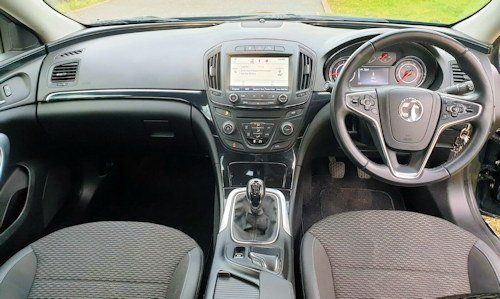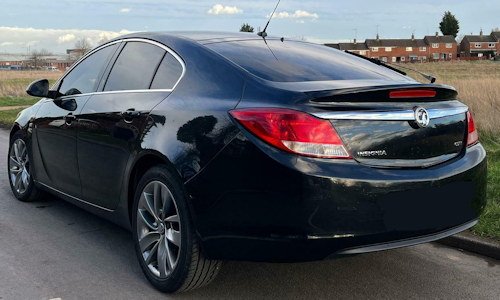Vauxhall Opel Insignia A
 | |
Production period: | 2008-2017 |
Class : | motor car |
Body versions : | Sedan , hatchback ,station wagon |
Engines: | Gasoline : 1.4-2.8 liters (85-239 kW) |
Length: | 4830-4913 mm |
Width: | 1856 mm |
Height: | 1498 mm |
Wheelbase : | 2737 mm |
Curb weight: | 1470-1843 kg |
The Vauxhall Opel Insignia A is a car model of the manufacturer Opel. And has been sold since autumn 2008.This replaced the Vectra made until summer 2008.
History
For the first time, the Insignia was presented in July 2008 at the British International Motor Show. For sale in November 2008, this came as a four-door notchback and five-door hatchback with full 5 Stars in the Euro-NCAP crash test .
In March 2009, followed by the estate wagon version,as the Sports Tourer is. It was presented in October 2008 at the Paris Motor Show.
The Buick Regal , which was released in autumn 2009, is identical to the Insignia. On the same platform GM Epsilon 2 are also based the Chevrolet Malibu and the Saab 9-5 II.
Until January 18, 2017, the model was ordered, the last vehicle rolled off the line in April. In total, Opel produced 944,670 Insignia of the first generation. The successor model Insignia B was launched on June 26, 2017.
The Insignia is slightly larger than the last Vectra, the price was slightly increased. Visually, the sedans are almost identical. The difference lies in the attack of the tailgate : The five-door hatchback this is struck on the roof, the four-door notchback below the rear window. In addition, the hatchback has a rear window wiper, which is not standard.
In June 2013, the Insignia underwent a facelift. The front lights were modified and provided with LED strips. In addition, the bumpers and the surround of the fog lights were changed. At the rear, similar to the Cascada cabriolet, a wide chrome clasp was integrated that extends right into the rear lights. The taillights received a standard LED brake light.
From a technical point of view, there were also changes: there were some new engines used, including two new turbocharged direct-injection gasoline engine, the 1.6-liter displacement 125 kW (170 hp) and 2.0 SIDI 184 kW (250 hp ) Afford. In the two smallest diesel engines, the power was increased by 10 hp (110 to 120 or 130 to 140 hp) and reduced consumption. The largest diesel engine was a new 2.0 CDTI with 143 kW (195 hp). In addition to the chassis, the interior has been thoroughly revised. The often criticized in the trade press operating system has been completely replaced, it was a larger and higher resolution display and the number of switches has been significantly reduced. In addition, there was a new control unit for the climate control, a new steering wheel and the optional semi-digital speedometer unit, where various information can be displayed on the central display as desired.
Towards the end of 2013, to complete the range of the station wagon also appeared a higher version, which was sold under the name Insignia Country Tourer . The vehicle offers increased ground clearance, off-road trim all around, underrun protection front and rear and widened fenders. The engine compartment was protected against damage from below with an underride protection made of aluminum plate.

The Insignia Country Tourer was equipped with two petrol engines (1.6 l with 125 kW / 170 hp and 2.0 with 184 kW / 250 hp) and two diesel engines (2.0 CDTI with 120 kW / 163 hp [since January 2015: 125 kW / 170 hp] and 143 kW / 195 hp). The two diesel engines and the more powerful petrol engine come as standard with all-wheel drive.
As the first vehicle in the Opel range, the Insignia received an improved headlamp system (called AFL +), in place of the previous installed in the Vectra AFL (bi-xenon with dynamic cornering light, static cornering lights own halogen reflector lamp with 90 ° beam angle and motorway light) also used special settings for specific driving conditions (eg bad weather light with other light density control to avoid self-glare, low-speed residential street light, automatic fade-in with high-beam assistant, etc.). The headlight units also received a daytime running light in LED technology.
Another novelty in this segment was the optionally available front camera. The so-called "Opel Eye" contains a lane departure warning system and traffic sign recognition, which recognizes certain traffic signs (speed restrictions, prohibition signs) and displays them on the display. The system was developed by Opel together with Hella . Lane Keeping Assist warns the unintended lane departure.
Haldex adaptive four-wheel drive is automatically active at vehicle startup to improve power transfer and, when traction is no longer needed on the rear axle, reduces fuel consumption by 90% of the torque to the front axle. Opel's Flex Ride Premium chassis can be adjusted in Normal , Tour and Sport modes . The instrument illumination is white, when activating the sport mode it changes to red.

For the first time there was in a Opel also side airbags for the rear seats, for the front seats has ventilation available
For the launch of the Opel Insignia there were seven engines to choose from: four petrol and three diesel engines. All engines met the standard Euro 5 standard .
The drive on the Insignia takes place via the front wheels. The exceptions are the 2.8-liter turbocharged petrol engine with 191 kW (260 hp) and 239 kW (325 hp) and the since 2011 sold 2.0-liter turbo with 184 kW (250 hp), as standard have four-wheel drive. For the two most powerful diesels, both drive concepts were available. The six-speed automatic transmission was offered for all engines except for the 1.4, 1.6 and 1.8-liter gasoline engines and the weakest diesel engine.
In the spring of 2009, two further engine variants were presented with a 1.6-liter turbo petrol engine with 132 kW (180 hp) and a 2.0-CDTI twin-turbo diesel with 140 kW (190 hp). was also earmarked a 2.9 V6 CDTI diesel with 550 Nm of torque and a power of 191 kW (260 hp).
An ecoFLEX version of the 2.0-liter diesel engine in 2009 extended the engine range of the Insignia. With modified aerodynamics and engine control, the 160-horsepower 2.0-liter CDTI achieves a CO 2 emissions of less than 140 g / km, equivalent to about 5.0 l of diesel per 100 km.
The OPC variant with a 2.8-liter V6 turbo engine offers a power of 239 kW (325 hp) and a maximum torque of 435 Nm and was available since summer 2009.In April 2011, offered Opel called the Unlimited version that dispenses with a limit on the maximum and achieved a notchback model with manual transmission up to 270 km / h.
In the spring of 2012 came a 2.0-liter twin-turbo diesel for the Insignia in the range, which makes 143 kW (195 hp) with a maximum torque of 400 Nm. This engine is an evolution of the 118 kW model. The consumption is given as 4.9 liters of diesel per 100 km. This engine was offered in all model variants and was also available in combination with all-wheel and automatic.
Introduced in October 2014 at the Paris Motor Show, the new "Whisper Diesel" with 2.0 l displacement, 125 kW (170 hp) and a torque of 400 Nm replaced since spring 2015, the 120 kW (163 hp) diesel. This Opel linked already to the new 1.6-liter diesel engines from the Astra J on. These are to have a drastically reduced noise and vibration level, more power and less consumption. Furthermore, this engine complies with the Euro 6 standard .

Rating
Technical
-
Vauxhall Opel Insignia A Technical details and specifications (2008-2017)
Petrol engines
1.4TurboecoFLEX
1.4 TurboLPGecoFLEX
1.6
1.6 Turbo
1.6 SIDITurbo ecoFLEX
1.8
2.0 Turbo (ecoFLEX)
2.0 Turbo (ecoFLEX) 4x4
2.0 SIDI Turbo ecoFLEX
2.8 V6 Turbo 4x4
2.8 V6 TurboOPC
Construction period
since 06.2011
since 07.2012
08.2008-
06.201208.2008-
06.2013since 06.2013
08.2008-05.2011, 06.2012-06.2013
08.2008-
06.201306.2011-
06.2013since 06.2013
08.2008-
06.2013since 07.2009
engine code
(A14NET)
(A16XER)
(A16LET)
(A16XHT)
(A18XER)
(A20NHT) / (A20NFT)
(A20NHH)
(A20NFT)
(A28NET)
(A28NER)
engine type
R4 engine with turbocharger and single injection
R4 single-injection engine
R4 engine with turbocharger and single injection
R4 engine with turbocharger and direct injection
R4 single-injection engine
R4 engine with turbocharger and direct injection
V6 engine with turbocharger and single injection
capacity
1364 cc
1598 cc
1796 cm³
1998 cm³
2792 cc
power
103 kW (140 hp)
at 4900-6000 min -185 kW (115 hp)
at 6000 min -1132 kW (180 hp)
at 5500 min -1125 kW (170 hp)
at 6000 min -1103 kW (140 hp)
at 6300 min -1162 kW (220 hp)
at 5300 min -1184 kW (250 hp)
at 5300 min -1184 kW (250 hp)
at 4500 min -1191 kW (260 hp)
at 5500 min-1239 kW (325 hp)
at 5250 min-1torque
200 Nm at
1850-4900 min -1155 Nmat
4000 min -1230 (266 withoverboost ) Nm at
2200-5500 min -1260 (280 with overboost) Nm at
1650-3200 min -1175 Nm at
3800 min-1350 Nm at
2000-4000 min -1400 Nm at
2400-3600 min -1400 Nm at
2500-4500 min-1350 Nm
(400 with overboost) at
1900-4500 min -1435 Nm at
5250 min -1Gearbox, standard:
6-speed manual transmission
Gear, optional:
-
6-speed automatic transmission
-
6-speed automatic transmission
Drive type, standard:
front-wheel drive
all wheel drive
front-wheel drive
all wheel drive
Drive type, optional:
-
all wheel drive
-
all wheel drive
-
Acceleration
0 to 100 km / h in s 110.9
12.4
12.9
8.9
9.2
11.4
7.6
7.5
6.9
6.0
Top speed,
km / h 1205
195
192
225
220
207
235
250
250 (electronically controlled)
250 (electronically controlled)
270 (OPC Unlimited)
Fuel consumption
(by EECDirective,
combined in l / 100 km) 15.7
7.6 (LPG)
7.5
7.7
6.3
7.6
8.9
8.4
7.8
11.6
11.4
CO 2emission,
combined in g / km 1134
124
179
184
149
179
197
184
258
249
Emission standardaccording to
EU classification5 euro
1 values apply to the saloon with standard gearbox and drive.
Diesel engines
1.6 CDTI(ecoFLEX)
1.6 CDTI (ecoFLEX)
2.0 CDTI (ecoFLEX)
2.0 CDTI (ecoFLEX)
2.0 CDT I (ecoFLEX)
2.0 CDTI (ecoFLEX)
2.0 CD TI (ecoFLEX)
2.0 CD TI (ecoFLEX)
2.0 CD TI (ecoFLEX)
2.0 BiTurbo CDTI (4x4)
2.0 BiTurbo CDTI (ecoFLEX)
Construction period
since 07.2015
08.2008-06.2013
06.2013-07.2015
08.2008-06.2015 2
06.2013-07.2015
08.2008-06.2013
06.2013-12.2014
since 01.2015
10.2008-10.2009
12.2011-06.2015
engine code
B16DTJ
B16DTH
A20DTC, A20DTL
A20DTC
A20DTJ
A20DTE
A20DTH
B20DTH
A20DTR
engine type
R4 diesel engine with turbocharger and common rail injection
R4 diesel engine withbi-turbocharger and common-rail injection
capacity
1598 cc
1956 cm³
power
88 kW (120 hp)
at 4000 min -1100 kW (136 hp)
at 3500-4000 min -181 kW (110hp )
at 4000 min-188 kW (120 hp)
at 4000 min -196 kW (131 hp)
at 4000 min-1103 kW (140 hp)
at 4000 min-1118 kW (160 hp)
at 4000 min -1120 kW (163 hp)
at 4000 min -1125 kW (170 hp)
at 3750 min -1140 kW (190 hp)
at 4500 min -1143 kW (195 hp)
at 4000 min -1torque
320 Nm at
2000 min-1320 Nm at
2000-2250 min -1260 (320 with overboost)Nm at
1750-2500min -1300 (320 with overboost) Nm at
1750-2500 min -1350 (370 with overboost) Nm at
1750-2500 min -1350 (380 with overboost) Nm at
1750-2500 min -1400 Nm at
1750-2500 min -1400 Nm at
2000 min -1400 Nm at
1750-2500 min -1Gearbox, standard:
6-speed manual transmission
Gear, optional:
-
6-speed automatic transmission
-
6-speed automatic transmission
-
6-speed automatic transmission
Drive type, standard:
front-wheel drive
Drive type, optional:
-
all wheel drive
Acceleration
0 to 100 km / h in s 111.9
10.9
12.1
11.9
11.1
10.5
9.5
9.0
8.5
8.7
Top speed,
km / h 1195
210
190
195
205
218
225
228
230
Fuel consumption
(according toEECdirective,
combined in l / 100 km) 13.8
3.8
4.4
3.7
4.4
3.7
4.9
4.4
4.5
6.0
4.9
CO 2emission,
combined in g / km 199
99
116
99
116
99
129
116
118
159
129
Emission standardaccording to
EU classificationEuro 6
5 euro
Euro 6
5 euro
5 euro
1 values apply to the saloon with standard gearbox and drive.
2 since 07.2013 only as automatic



